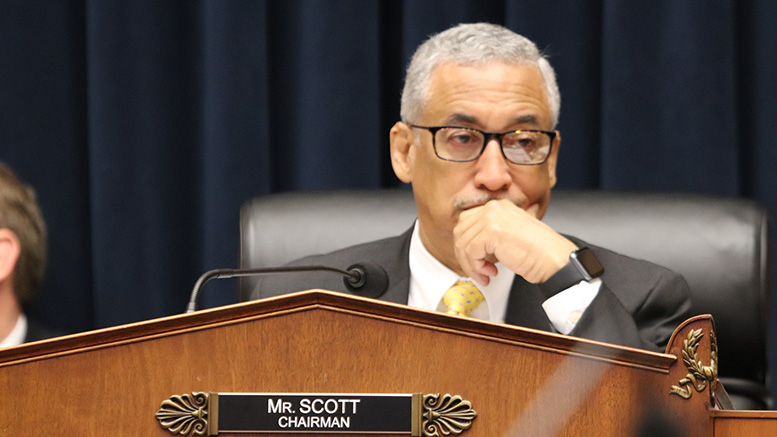As expected, the House Education and Labor Committee on Thursday approved the College Affordability Act (H.R. 4674), a comprehensive reauthorization of the Higher Education Act (HEA).
Republican members offered a series of amendments over a three-day markup that were mostly rejected. This was the same pattern reflected less than two years ago, when the Republican-controlled education committee approved its HEA reauthorization legislation, the PROSPER Act.
Committee Chair Rep. Bobby Scott (D-Virginia) said he hopes the House will take up the legislation this year. If that occurs, it might pressure the Senate Health, Education, Labor and Pensions Committee to advance its own reauthorization legislation. So far, that process has run aground.
An ambitious bill
The College Affordability Act (CAA) is extraordinarily ambitious. It has a huge price tag of approximately $400 billion over 10 years for just the “mandatory,” non-appropriations portions of the bill, and it would greatly alter federal engagement with higher education.
As the American Association of Community Colleges (AACC) measures the bill’s full implications, a few prominent features for community colleges include:
Pell Grant funding expansion: The legislation would increase the maximum Pell Grant award by $625 in award year 2021-22 with guaranteed funding, and automatically increase it by the Consumer Price Index for subsequent award years. The current lifetime eligibility cap of 12 semesters would increase to 14. Taken together, these longstanding AACC priorities represent a positive core feature of the bill.
Another top priority addressed in the bill is new eligibility for incarcerated students, the so-called “Second Chance” Pell.
However, the bill also would extend Pell grants to otherwise qualifying graduate and professional students in their first postbaccalaureate program who meet Pell Grant eligibility criteria — a dramatic change from current law.
To qualify, students must have received a Pell Grant as an undergraduate and not used up all 14 semesters of eligibility. But, for example, an MBA student could have received Pell grants for one year as an undergraduate and then have six years of programmatic eligibility remaining.
In any case, AACC finds this proposed policy problematic because, since its inception, Pell grants have been targeted on undergraduates. More importantly, the program is extremely expensive as is and simply cannot absorb the financial burden of America’s postbaccalaureate student population.
Related articles: ‘Washington Watch: House HEA bill heads to mark up next week‘ and ‘House Dems pitch comprehensive HEA bill’
Short-term Pell Grant eligibility: CAA would establish Pell Grant eligibility for credit and non-credit programs between 150 and 600 clock hours, in length of at least eight weeks. While this is in some ways a huge win reflecting one of AACC’s top reauthorization priorities, in practice the bill’s requirements may prevent many community college programs from qualifying.
As in the bi-partisan JOBS Act, which AACC supports, programs would need to be listed on the Workforce Innovation and Opportunity Act (WIOA) eligible provider list, and non-credit programs would need to be subsequently articulated into credit programs at the institution. (AACC is told by its member colleges that this could be difficult in some cases; in others, not at all.)
Critically, in order for the program to qualify, six months after completing a program students would have to earn more than the average high school graduate — which is approximately $37,000, though it would vary by states and regions.
The programs must also pass CAA’s gainful-employment requirements and be part of a career pathway as defined in WIOA, which in turn requires a program to offer or connect to a GED program. The U.S. education secretary must approve programs and can take up to 180 days to do so. Finally, the secretary must re-approve programs every three years.
What does all this mean? For one thing, just because a community college offers what officials know to be a high-quality short-term program, the CAA, in its effects, might beg to differ. It also means that AACC will work on CAA’s short-term Pell Grant provisions in the weeks to come, and that we will need your help.
Accreditation: Improving the performance of postsecondary institutions through the accreditation process has long been on the minds of policymakers from both parties. In fact, House Committee Chair Scott mentioned his interest in this area when he met with AACC President and CEO Walter Bumphus. Even the smallest changes to the accreditation statute can create major distress in the academic community. This has proven to be the case with CAA’s accreditation provisions, which are significant through any lens.
AACC’s primary concern with CAA’s accreditation changes is that they would allow the education secretary to reject an agency’s standards in three key areas – completion (which may include transfer), workforce participation (which could include licensure pass rates, job placement or employment), and progress towards meeting the first standard – as being insufficient.
How this new authority might operate in practice is anyone’s guess. But the notion that the department can, more or less at will, set what amounts to “bright lines” for accrediting agencies is anathema to AACC because it directly conflicts with the way that accreditation operates — as a peer-review mechanism. That said, Congress has an undeniable right and obligation to ensure that federal funds are spent responsibly, and this aspect of the legislation could become a flashpoint.
Feedback on CAA: AACC/ACCT this week sent a letter to the House Education and Labor Committee
The College Affordability Act contains hundreds of other provisions that would affect community colleges and their students, some of them with a huge potential impact, such as America’s College Promise and new grant programs for dual enrollment, student success and developmental education. The bill has scores of positive features that would help students and institutions alike.
AACC looks forward to working with the House to improve the legislation as it makes its way through the House, and then, hopefully, towards final enactment.





